1. INTRODUCTION
In this paper, we consider Lane-Emden type equations:
subject to the homogeneous initial conditions
or to the nonhomogeneous initial conditions
where α and β are known constants, f(x,v) is a continuous real valued function, and g(x) Є C[0,ℓ].
Lane-Emden equations have attracted the attention of many mathematicians and physicists due to their great importance in many fields. They can model many phenomena in mathematical physics and astrophysics such as thermal explosions (Chambre 1952), stellar structure (Chandrasekhar 1958) and isothermal gas spheres and thermionic currents (Richardson 1921). For example, equation (1) is of physical interest when
Therefore the solutions of these problems are of practical interest as the radius of the star ξ ∞ x and the pressure P ∞ e -v . From a mathematical point of view, the Lane-Emden equation is a singular initial value problem. Many authors have proposed approximate solutions to this type of equations. For example, Mohan & Al-Bayaty (1980) have introduced approximations by means of a convergent power series. Also, Hunter (2001) has discussed a simple Euler-transformed series that converges significantly faster. In Saad (2004) and Nouh (2004), accelerated power series solutions are developed for polytropes and isothermal spheres. We also refer the reader to Iqbal & Javed (2011); Bhrawy & Alofi (2012); Doha et al. (2013); Căruntu & Bota (2013); Abd-Elhameed (2015) and Doha et al. (2015) for other proposed numerical solutions to this type of equations.
Mathematically, spectral methods are built by approximating the series solutions for differential equations in terms of special functions, and in particular, orthogonal polynomials, say ∑ akϕk . There are three well-known versions employed as popular techniques to determine the expansion coefficients namely collocation, Tau and Galerkin methods (see Canuto et al. (1988)). Each version has its importance in various applications. The application of the collocation method requires that the residual of the given differential equation vanishes at some selected collocation points. The Tau method is a synonym for expanding the residual function as a series of orthogonal polynomials and then applying the boundary (initial) conditions as constraints. The Galerkin approach is based on selecting suitable combinations of orthogonal polynomials as basis functions which satisfy the boundary (initial) conditions, and then forcing the residual to be orthogonal with the basis functions. Abd-Elhameed (2015) successfully employed the Galerkin method for solving such problems.
The article is organized as follows. In § 2, some relevant properties of third and fourth kind Chebyshev polynomials and their shifted ones are presented. In § 3, two new choices of Galerkin basis functions are introduced. Moreover, two new operational matrices of derivatives of third and fourth kind Chebyshev polynomials are developed. In § 4, we employ the developed operational matrices together with collocation and Galerkin spectral methods for solving the Lane-Emden type equations. In § 5, we consider the solar model polytrope with n = 3 as an example to show that the suggested solutions in this paper are applicable and achieve high accuracy using a small number of terms. We end this article with some concluding remarks.
2. THIRD AND FOURTH KIND CHEBYSHEV POLYNOMIALS
Chebyshev polynomials Vk (x) and Wk (x) are orthogonal on (-1,1) in the sense that
where δ kj is the well-known Kronecker delta function.
They satisfy, respectively, the following two recurrence relations:
with the initial values
and
with the initial values
For more properties and applications of Chebyshev polynomials, the reader is referred to the beautiful book of Mason & Handscomb (2003).
The shifted third and fourth kind Chebyshev polynomials are defined on [0,ℓ], respectively as
These polynomials are orthogonal on [0,ℓ] in the sense that
where
3. SHIFTED THIRD AND FOURTH KIND CHEBYSHEV-GALERKIN OPERATIONAL MATRICES
The main objective of this section is to introduce two new Galerkin operational matrices of derivatives of a certain basis of Chebyshev polynomials of the third and fourth kind. To be more precise, we choose two kinds of basis functions in terms of Chebyshev polynomials of the third and fourth kind which satisfy the homogeneous initial conditions (2). In this respect, consider the following two choices of basis functions:
and
It is not difficult to see that each of the two families of polynomials {ϕ k(x) : k = 0,1,2,...} and {ϕ k(x) : k = 0,1,2,...}are orthogonal on [0,ℓ] with respect to the weight functions
Now, for any two functions, v(x)
and
where the coefficients c
i
and  are given respectively by
are given respectively by
Therefore, the two series in Eqs. (10) and (11) can be approximated respectively to give
where
and
Now, we are going to state the following two theorems concerning the expressions of the first derivative of each of the two polynomials given in (8) and (9) in terms of the Chebyshev polynomials of the third and fourth kind themselves. From these two derivatives formulae, the Galerkin operational matrices of third and fourth kind can be extracted.
Theorem 1 Let ϕi(x) be the polynomials chosen in (8). The following relation holds for all i ≥ 1
Theorem 2 Let (x) be the polynomials chosen in (9). The following relation holds for all i ≥ 1
(x) be the polynomials chosen in (9). The following relation holds for all i ≥ 1
Now, and with the aid of Theorems 1 and 2, the first derivative of the two vectors ϕ(x) and  (x) defined in (16) and (17) can be expressed respectively in the following two matrix forms:
(x) defined in (16) and (17) can be expressed respectively in the following two matrix forms:
where ɳ(x) = (ɳo(x), ɳ 1(x),..., ɳ n
(x))T ,
For example, for N = 5 the two operational matrices A and Ā are the following (6 x 6) matrices
Remark 1 From (20) and (21), it is easy to see that the second derivative of the two vectors ϕ (x) and  (x) can he represented in the following two matrix forms:
(x) can he represented in the following two matrix forms:
4. LANE-EMDEN TYPE EQUATIONS
In this section, we discuss in detail how the third and fourth Chebyshev-Galerkin operational matrices can be employed for solving Lane-Emden type equations. In fact, the two spectral methods, namely Chebyshev of the third kind Galerkin operational matrix method (C3GOM) and Chebyshev of the fourth kind Galerkin operational matrix method (C4GOM) are employed to obtain numerical approximate solutions for linear Lane-Emden type equations. The nonlinear ones are handled through the application of the two spectral methods, namely Chebyshev of the third kind collocation operational matrix method (C3COM) and Chebyshev of the fourth kind collocation operational matrix method (C4COM).
In the following, we implement the two algorithms, namely, C3GOM and C3COM; the other two algorithms can be implemented similarly.
4.1. Treatment of linear equations
Consider the linear Lane-Emden equation
subject to the homogenous initial conditions
If we make use of relations (14), (20) and (22), the following approximations are obtained
then one can write the residual of Eq. (24) as
The application of the Galerkin method (see, Canuto et al. (1988)) yields the following (N+l) linear equations in the unknown components of the vector C, namely
These equations can be solved for the unknown components of the vector C, and hence the approximate spectral solution vn(x) given in (14) can be obtained.
Test problem 1 [Iqbal & Javed (2011); Bhrawy & Alofi (2012); Cǎruntu & Bota (2013); Khun & Sayfy (2014); Abd-Elhameed (2015) ]
The following nonhomogeneous linear Lane-Emden equation
has the exact solution v(x) = X4 - X3. If we apply C3GOM and C4GOM with N = 2, then we have CT = [
 = [
= [
4.2. Nonlinear equations
Now, we are able to treat the more general nonlinear Lane-Emden IVP (1) subject to the homogeneous initial conditions (2).
Again, if v(x) and the derivatives v'(x), v"(x) are approximated as in (14), (20) and (22), one can write the residual Rn(x) of equation (1) in the form
To find the numerical solution vn(x), we apply the collocation method that forces the residual Rn(x) given in equation (29) to vanish at (N + 1) selected collocation points for the variable x. For this purpose, we select the collocation points to be the (N + 1) roots of the polynomials Vn+1(x). Hence, a set of (N + 1) nonlinear equations is generated in the unknown components of the vector C. With the aid of the well-known Newton iterative method, this nonlinear system can be solved, and hence the corresponding approximate solution can be obtained.
Test problem 2 [Khun & Sayfy (2014)]
The following nonlinear Lane-Emden equation
has the exact solution v(x) = e -2x2 . Figure 1 displays the absolute error obtained by C3COM and C4COM with N = 16 which shows that our methods is in good agreement with the exact solution. In order to make a comparison with the two methods CS and ACS in Khuri & Sayfy (2014), we the best obtained maximum absolute errors (MAE) by our methods and these methods in Table 1.
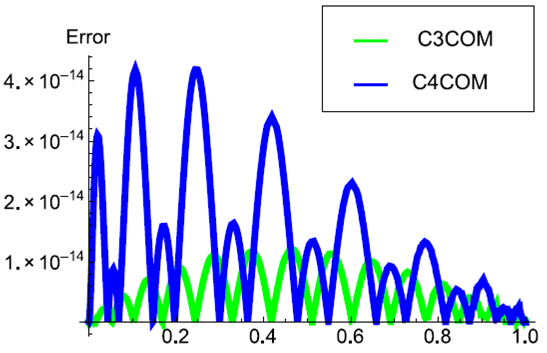
Fig. 1 The absolute errors as a function of radius obtained by C3COM and C4COM with N = 16 for Test Problem 2.
5. APPLICATIONS
As an application, we consider a polytropic model for the Sun with index n = 3, i.e
The power series solutions suggested by Roxburgh & Stockman (1999) need about 1000 terms to converge. Hunter (2001) used the Euler-transformation for accelerating the convergence of the power series and found that 60-terms are needed to obtain v(x) to a 7 decimal place accuracy. Saad (2004) accelerated the power series solutions to obtain v(x) to an 8 decimal place accuracy using 24 terms only. If we apply our methods C3COM (N = 21) and C4COM (N = 24), we obtain v(x) to a 7 decimal place accuracy. The methods C3COM and C4COM give v(x) = 0 at x = 6.89684863 and x = 6.89684865, respectively, which differ from the numerical solution by 1.91517 x 10-8 and 3.34973 x 10-8, respectively.
5.1. Physical parameters
Some useful relations for the physical parameters of the polytropes can be derived using the spectral solution v n(x) obtained. The mass M contained in a sphere of radius r is given by
where
K, pc and G are the polytropic constant, the central density and the gravitational constant, respectively. The pressure in the polytropic gas sphere is written as
where K is the polytropic constant. For an ideal gas, the temperature is given by
where μ is the mean molecular weight, m p is the mass of atomic hydrogen, and k is the Boltzmann constant. For the solar polytropic model, the observed mass and radius are given by M = 1.989 x 1033 g and R = 6.96 x 1010 cm, respectively. In order to make a comparison between the evaluated physical parameters using C3COM and those from numerical computations, Figures 2, 3, 4 and 5 display the ratios M/M sun, ρ/ρ c, P/Pc and T/T c, respectively, as a function of radius. From these figures, we found that the maximum relative error in the mass ratio is of order of 10-6, while the errors in density, pressure and temperature ratios are of order of 10-5.
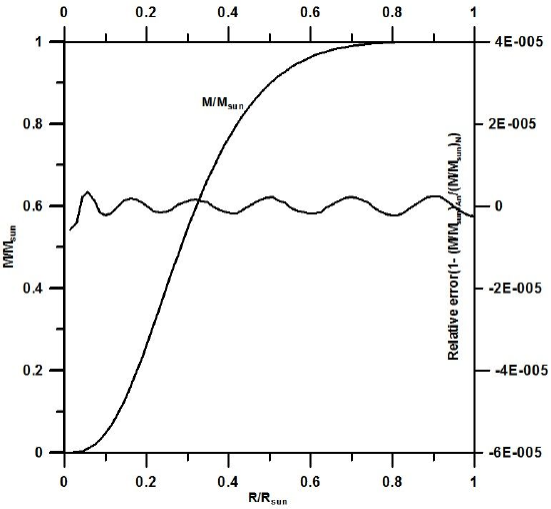
Fig. 2 The ratio M/Msun as a function of radius for the solar model poly trope. This figure shows the variations of mass with radius. The C3COM (dotted line) and numerical (solid line) solutions overlap and cannot be distinguished. The maximum relative error is 6 x 10-6 for the whole solution.
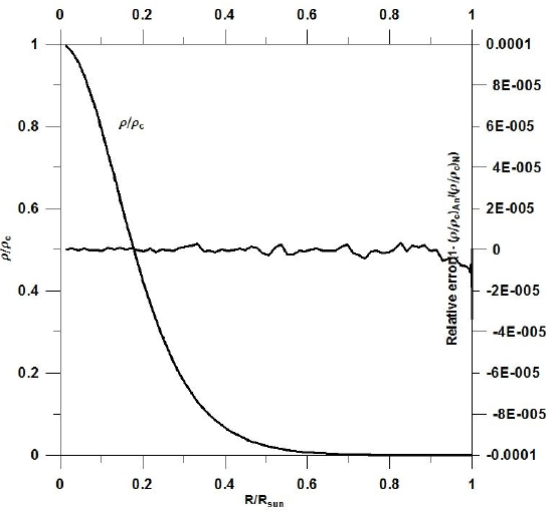
Fig. 3 The ratio p/p c as a function of radius for the solar model polytrope. This figure shows the variations of density with radius. The C3COM (dotted line) and numerical (solid line) solutions overlap and cannot be distinguished which shows the good agreement; the polytrope gives the central density at the core of the star and then decreases gradually outwards. The maximum relative error is 3 x 10-5 for the whole solution.
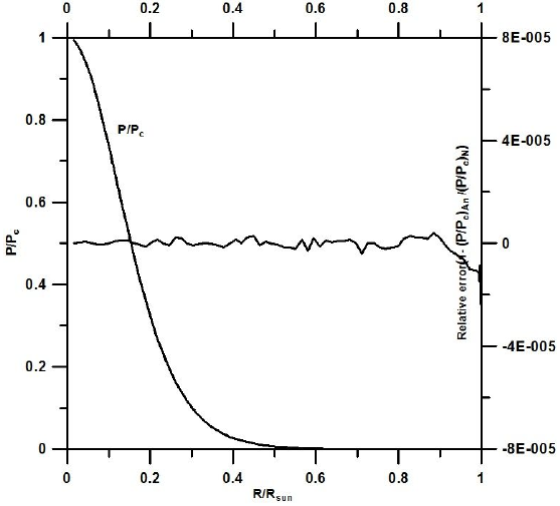
Fig. 4 The ratio P/Pc as a function of radius for the solar model polytrope. This figure shows the variations of pressure with radius. The C3COM (dotted line) and numerical (solid line) solutions overlap and cannot be distinguished which shows the good agreement; the polytrope gives the central pressure at the core of the star and then decreases gradually outwards. The maximum relative error is 4 x 10-5 for the whole solution.
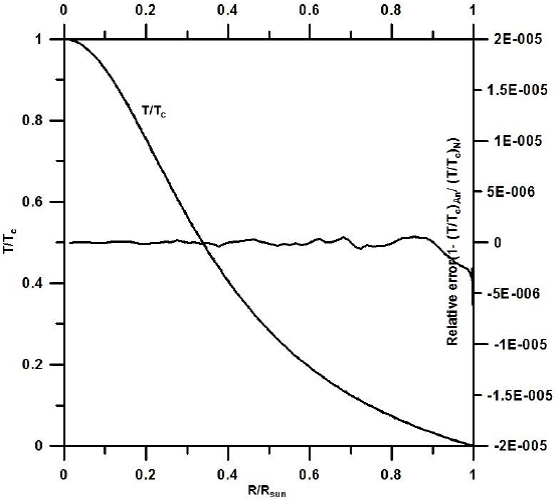
Fig. 5 The ratio T/T c as a function of radius for the solar model polytrope. This figure shows the variations of temperature with radius. The C3COM (dotted line) and numerical (solid line) solutions overlap and cannot be distinguished, which shows the good agreement; the polytrope gives the central temperature at the core of the star and then decreases regularly outwards. The maximum relative error is 1.3 x 10-5 for the whole solution.
6. CONCLUDING REMARKS
In this paper, the third and fourth kind Chebyshev-Galerkin operational matrices are derived in detail. Literal approximate solutions are developed to Lane-Emden equations using these operational matrices along with spectral methods. An application to the solar model polytrope is introduced to show that the suggested solutions are in good agreement with the numerical results. The algorithms developed are simpler in implementation than those introduced in Roxburgh & Stockman (1999); Hunter (2001); Saad (2004) and they achieve high accuracy using a small number of terms. The numerical results obtained are convincing and they indicate that the proposed algorithms are efficient.











 nueva página del texto (beta)
nueva página del texto (beta)













































